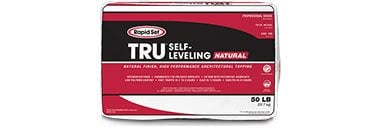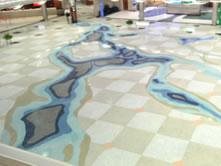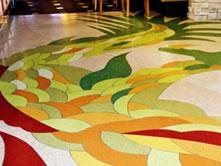Epoxy Terrazzo Flooring and Supplies
Learn about the design options and installation techniques for this high-performance epoxy coating.Invented by the Venetians in the 1500s, cement-based terrazzo is one of the oldest types of decorative flooring systems. This mosaic-like floor topping made by embedding small pieces of marble or granite in mortar, followed by polishing is still highly prized for its timeless beauty. But a newer type of terrazzo has entered the scene, offering a host of benefits that threaten to shrink the market for traditional cement-based systems.
This formidable competitor is thin-set epoxy terrazzo a poured-in-place topping for concrete substrates that goes on at a thickness of only 1/4 to 3/8 inch, as opposed to traditional terrazzo that must be applied at thicknesses of 2 to 3 inches. This modern-day terrazzo is excellent for multicolored patterns and designs because the epoxy resin matrix can be pigmented, like paint, to achieve an unlimited spectrum of colors. And it can accommodate a wider variety of richly colored aggregates, including chips of marble or granite, recycled glass, mother of pearl, and various synthetic materials. With the creative use of divider strips to separate areas of contrasting colors, it's possible to produce borders, logos, geometrical designs, and other artistic compositions.
Shop: Find terrazzo flooring & supplies
"But the aesthetic value of epoxy terrazzo isn't the only reason these toppings are gaining in popularity, and why they have captured more than 70 percent of today's terrazzo market," according to George Hardy, executive director of the National Terrazzo & Mosaic Association (NTMA). They also offer outstanding durability and wear, making them tough enough for use in high-traffic commercial and industrial environments. Because the binder is 100% epoxy, the finished floor surface provides greater resiliency, chemical resistance, compressive strengths, and flexibility than cement-based systems.
Hire a pro: Find concrete floor contractors near me
"Epoxy terrazzo is extremely long wearing," says Robert Cain, president of Key Resin Co., Batavia, Ohio. "It's a 40-year life-expectancy floor, and has the lowest life-cycle cost of any hard floor surface."
Advantages of Thin-Set Epoxies vs. Other Types of Terrazzo
The National Terrazzo & Mosaic Association says that epoxy terrazzo is the best thin-set system available, offering the lowest maintenance costs and the quickest pour-to-grind installation time.
There are a few other types of thin-set systems, such as polyacrylate (a latex-fortified cement) and monolithic (a cement-based system with a thin cross-section), but epoxy terrazzo is generally stronger and more durable. Its also less prone to cracking, says Hardy.
The epoxy resin cures overnight and can be polished the next day, permitting faster project turnaround. Traditional terrazzo may require up to seven days of curing before polishing can begin. In addition to the quick curing and finishing time, epoxy terrazzo is also lighter in weight (only about 3 pounds per square foot installed) than thicker cement-based terrazzos. This makes the material more suitable for multistory use.
Other attributes of epoxy terrazzo include:
- Abrasion resistance
- Excellent stain and chemical resistance
- High impact resistance
- Thermal-shock resistance
- Does not shrink, permitting installation of larger monolithic sections
- The colors are permanent and will last the life of the floor without fading
- No need for depressed or recessed concrete slabs to accommodate the topping thickness
- Nonporous finish does not support bacterial growth, mold, or mildew
- Low maintenance (surfaces are seamless)
- Extremely durable, which translates into lower life-cycle costs
 Terrazzi Floor System
Sprayable resurfacing compound with cast-on aggregates
Terrazzi Floor System
Sprayable resurfacing compound with cast-on aggregates
 CPS G-170 Electric
17" Floor Grinder 230 volt ($7,600)
CPS G-170 Electric
17" Floor Grinder 230 volt ($7,600)
 Self-Leveling Polishable
Self-Leveling Polishable Overlay Long working time, smooth surface, polishable topping
Care and maintenance of epoxy terrazzo floors
Because epoxy terrazzo surfaces are smooth, seamless, and nonporous, they are very easy to clean and won't harbor the growth of mold or mildew. They also resist staining caused by chemical, oil, and grease spills. Most manufacturers recommend simply washing the surface with a neutral cleaner, followed by rinsing. In high-traffic areas, the surface should be protected by at least two coats of acrylic or urethane sealer to reduce wear.
Epoxy terrazzo floor coating limitations
Although epoxy terrazzo offers many benefits when compared with other decorative floor toppings, it does have some limitations. Probably the biggest drawback is that the system is nonbreathable, so it traps moisture vapor transmission coming up from the concrete slab. This can result in loosening of the epoxy topping or improper curing. When epoxy terrazzo is installed onto concrete slabs on grade, manufacturers often recommend the installation of a good vapor barrier.
"While moisture transmission is a problem, I wouldn't single out epoxy terrazzo," says Cain. "It's just one of many floor surfaces that can be affected. Moisture transmission can also be a problem with ceramic or resilient tile, wood, and carpeting."
"Another downside is the high cost of initial installation, due to the labor and skill level involved. It's usually not an economical surface to put down in facilities that won't be around for decades," Cain admits. "It's a 40-year floor. If you stretch the cost over the floors life span, though, the maintenance and installation costs are very low."
Other potential limitations:
- Epoxy terrazzo is generally not recommended for outdoor use because of concerns about UV exposure.
- Once the epoxy is mixed, it has a working time of only 45 minutes to an hour, so it must be placed without delay. Learn more about epoxy terrazzo installation.
- Because divider strips should be installed directly over all control and expansion joints in the slab (to prevent the topping from cracking at those locations), the strips can interfere with some designs.
Concrete Terrazzo Coatings - Design Options
The color and design possibilities with epoxy terrazzo are limitless, allowing the creation of elaborate works of floor art.
"Design engineers go nuts over the beautiful layouts and designs you just can't get with any other type of hard-surface flooring," says Cain. As an example, he points to epoxy terrazzo installations at Disney World in Orlando, Fla., which incorporate replications of Mickey Mouse and other Disney characters.
The epoxy matrix can be tinted any color, ranging from vivid reds and blues to subtle pastel shades. Many manufacturers also offer computer-matched custom colors. "It's just like paint," says Hardy. "Any color can be reproduced."
However, the epoxy matrix only serves as the setting for the brilliant jewels of decorative aggregate. When revealed by polishing, they provide a rhapsody of sparkling color accents that can either contrast with or complement the epoxy base.
The divider strips further extend the designers freedom. They can be used to separate different colors of terrazzo mixes for intricate designs or as an accent themselves. The dividers are available in a variety of materials including zinc, brass, and colored plastic. They can also be specified in different sizes and shapes.
"Often the divider strips are bent right on the jobsite," says Cain. "On real intricate jobs, some terrazzo contractors bring in an artist to draw the design right on the floor. Then the contractor uses that design as a template to lay out the strips."
Terrazzo floor color chart - glass aggregates
These sample color are from Heritage Glass to provide you with ideas of the color selection you have when selecting glass aggregates for terrazzo flooring. These terrazzo aggregates are 98% recycled glass. They provide a durable floor surface suitable for homes, restaurants, businesses, schools, commercial buildings, grocery stores, airports and many other flooring surfaces.
Heritage Glass Aggregate Colors
 Co Blue 7
Co Blue 7
 Co Blue 5
Co Blue 5
 Co Blue 3
Co Blue 3
 Co Blue 1
Co Blue 1
 Aqua 5
Aqua 5
 Aqua 2
Aqua 2
 T Blue 5
T Blue 5
 Co Blue 1
Co Blue 1
 Calm Sea
Calm Sea
 Nordic Blue
Nordic Blue
 Spring Time
Spring Time
 SC Co Blue
SC Co Blue
 Sage Green
Sage Green
 Utah House
Utah House
 Dave's Green
Dave's Green
 Bottles
Bottles
 CR Green 6
CR Green 6
 Forest Green
Forest Green
 FN Green 3
FN Green 3
 Mixed Bottles
Mixed Bottles
 Clear Plate
Clear Plate
 White
White
 Clear
Clear
 Crushed Mirror
Crushed Mirror
 Black
Black
 Silver Coated
Silver Coated
 Weathered
Weathered
 Dark Blue Violet
Dark Blue Violet
 Plum 7
Plum 7
 CS Amber 9
CS Amber 9
 Amber Bottles
Amber Bottles
 Autumn Fields
Autumn Fields
 Yellow
Yellow
 Polk Gold
Polk Gold
 Chocolate Chip
Chocolate Chip
 Apricot
Apricot
 T Orange
T Orange
 Burnt Orange
Burnt Orange
 CA Red
CA Red
 War Dance
War Dance
 Rasberry
Rasberry
 Drake
Drake
You may find more information on these samples at Heritage Glass Inc.






